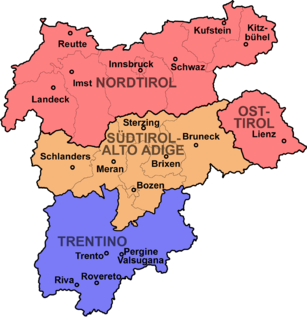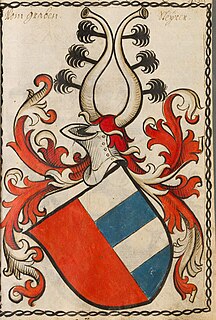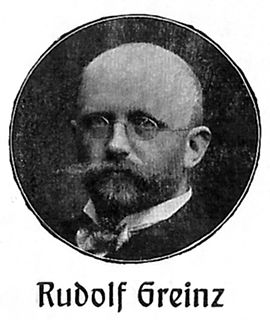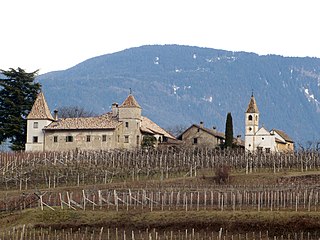
Bolzano is the capital city of the province of South Tyrol in northern Italy. With a population of 108,245, Bolzano is also by far the largest city in South Tyrol and the third largest in Tyrol. The greater metro area has about 250,000 inhabitants and is one of the urban centers within the Alps.

Trentino-Alto Adige/Südtirol is an autonomous region of Italy, located in the northern part of the country. Since the 1970s, most legislative and administrative powers have been transferred to the two self-governing provinces that make up the region: the Province of Trento, commonly known as Trentino, and the Province of Bolzano, commonly known as South Tyrol.

A manor house was historically the main residence of the lord of the manor. The house formed the administrative centre of a manor in the European feudal system; within its great hall were held the lord's manorial courts, communal meals with manorial tenants and great banquets. The term is today loosely applied to various country houses, frequently dating from the late medieval era, which formerly housed the gentry.

Brixen is a town in South Tyrol in northern Italy, located about 40 kilometres (25 mi) north of Bolzano.

An English country house is a large house or mansion in the English countryside. Such houses were often owned by individuals who also owned a town house. This allowed them to spend time in the country and in the city—hence, for these people, the term distinguished between town and country. However, the term also encompasses houses that were, and often still are, the full-time residence for the landed gentry that ruled rural Britain until the Reform Act 1832. Frequently, the formal business of the counties was transacted in these country houses, having functional antecedents in manor houses.
Air Alps,, was an Austrian regional airline based in Innsbruck.

Neumarkt is a comune (municipality) in South Tyrol in northern Italy, located about 25 kilometres (16 mi) south of the city of Bolzano.

The Free University of Bozen-Bolzano is a university primarily located in Bolzano, Italy. It was founded on 31 October 1997 and is organized into five Faculties.

The Gehry Residence is architect Frank Gehry's own house. It was originally an extension, designed by Gehry and built around an existing Dutch colonial style house. It makes use of unconventional materials, such as chain-link fences and corrugated steel. It is sometimes considered one of the earliest deconstructivist buildings, although Gehry denies this.

Runkelstein Castle is a medieval fortification on a rocky spur in the territory of Ritten, near the city of Bolzano in South Tyrol, Italy. In 1237 Alderich Prince-Bishop of Trent gave the brothers Friedrich and Beral Lords of Wangen permission to construct a castle on the rock then called Runchenstayn.

Hockey Club Bolzano Foxes, also known as commercial name HCB Alto Adige Alperia or HCB Südtirol Alperia is an Italian ice hockey team located in the city of Bolzano, South Tyrol autonomous province, that plays in the Austrian Hockey League (EBEL). It remains the most successful team in the history of the Italian Serie A, with 19 championships.

In 1919, at the time of its annexation, the middle part of the County of Tyrol which is today called South Tyrol was inhabited by almost 90% German speakers. Under the 1939 South Tyrol Option Agreement, Adolf Hitler and Benito Mussolini determined the status of the German and Ladin (Rhaeto-Romanic) ethnic groups living in the region. They could emigrate to Germany, or stay in Italy and accept their complete Italianization. As a consequence of this, the society of South Tyrol was deeply riven. Those who wanted to stay, the so-called Dableiber, were condemned as traitors while those who left (Optanten) were defamed as Nazis. Because of the outbreak of World War II, this agreement was never fully implemented. Illegal Katakombenschulen were set up to teach children the German language.

Graben von (zum) Stein, also named ab dem Graben, von (dem) Graben and vom Graben, was the name of an old Austrian noble family. Originally from Carniola, an apparent branch of the House of Meinhardin, the family went on to rule some Carinthian, Lower Austrian, Tyrolian, East Tyrols, Styrian, Gorizian and modern Italian districts as Burggrafen and Herren (lords) from the early Middle Ages until the 16th-17th centuries.

The Brenner Railway is a major line connecting the Austrian and Italian railways from Innsbruck to Verona, climbing up the Wipptal, passing over the Brenner Pass, descending down the Eisacktal to Bolzano/Bozen, then further down the Adige Valley to Roverto/Rofreit, and along the section of the Adige Valley, called in Italian the “Vallagarina”, to Verona. This railway line is part of the Line 1 of Trans-European Transport Networks (TEN-T). It is considered a "fundamental" line by the state railways Ferrovie dello Stato (FS).

Bolzano/Bozen railway station is the main station of Bolzano/Bozen, capital of the autonomous province of Alto Adige/Südtirol, in northeastern Italy.
The following is a timeline of the history of the city of Bolzano/Bozen in the Trentino-South Tyrol region of Italy.

In der Maur is an ancient armigerous family of Swiss origin. Throughout the Middle Ages and Renaissance, the In der Maur family held positions of regional administrative authority in the government of Farniwang, later known as Berneck, St. Gallen. A branch of the family living in South Tyrol, von In der Maur auf Strelburg und zu Freifeld, was elevated into the ranks of the lower nobility within the Holy Roman Empire and the Kingdom of Bavaria. Prominent members of the family include the Swiss artist Robert Indermaur and the Austrian statesman Carl von In der Maur, who served as Governor of Liechtenstein.

Rudolf Greinz was an Austrian writer. He was born as the eldest of five children of Anton Greinz and his wife Maria. His younger brothers Hugo (1873–1946) and Hermann (1879–1938) were also writers. In 1879 the family moved to Salzburg. his father had been transferred there.

Bozner Blutsonntag refers to the events of 24 April 1921 in Bozen. It was the first climax of fascist violence in South Tyrol, a German-speaking province that was annexed by Italy after World War I.

Ansitz Kreit is an Ansitz in Eppan an der Weinstraße, South Tyrol, Italy.



















